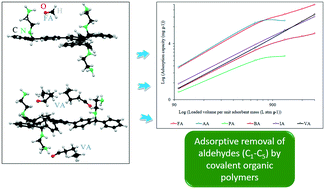Amine-functionalized microporous covalent organic polymers for adsorptive removal of a gaseous aliphatic aldehyde mixture†
Abstract
To pursue effective removal of gaseous volatile organic compounds (VOCs), adsorptive removal of a six-component aliphatic aldehyde mixture in gas phase (i.e., formaldehyde (FA), acetaldehyde (AA), propionaldehyde (PA), butyraldehyde (BA), isovaleraldehyde (IA), and valeraldehyde (VA)) was investigated using two microporous covalent organic polymers (COPs) functionalized with ethylenediamine (CBAP-1 (EDA) [CE]) and diethylenetriamine (CBAP-1 (DETA) [CD]); CBAP represents a carbonyl-incorporated aromatic polymer. A commercial activated carbon (AC) was utilized as a reference adsorbent. The gaseous aliphatic aldehyde mixture was composed of ∼1 Pa (FA/AA) and ∼0.2 Pa (PA/BA/IA/VA) with methanol (2.6 Pa) and water (15 Pa). CE displayed the highest 10% breakthrough volume (BTV10) values for FA and VA of 714 and >2400 L atm g−1, respectively. The apparent superiority of CE over CD (e.g., in terms of BTV10 values) was limited to the lighter aldehydes (FA, AA, and PA) when compared in terms of adsorption capacity values at 50% breakthrough. The adsorption capacity values (at 50% breakthrough) for CE ranged from 14 (FA) to >13 mg g−1 (VA), while those for CD were 11 (FA) to >13 (VA) mg g−1. The results of AC were far smaller at 0.003 (FA) to 7 (VA) mg g−1. Density functional theory (DFT)-based simulations indicated the non-covalent interactions between carbonyl groups present in aldehyde molecules and the amine functionalities present in COPs as the primary mechanism while the formation of a Schiff base/imine (covalent interaction) as a less favorable (secondary) pathway. In addition, the dipole–dipole interactions between the amine-functionalized COP surface and the carbonyl group of aldehydes promoted the transformation of the weak van der Waals forces into robust electrostatic interactions with the prominent appearance of such a process in heavier aldehydes. As such, the results of DFT calculations agreed well with the adsorption kinetics and material characterization data. Consequently, the COP–aldehyde interactions reflected a synergistic combination of physical and chemical adsorption. On the whole, the present study is expected to contribute to the establishment of suitable strategies for the fabrication of advanced adsorbents to effectively treat gaseous VOC mixtures under real-world conditions.



 Please wait while we load your content...
Please wait while we load your content...